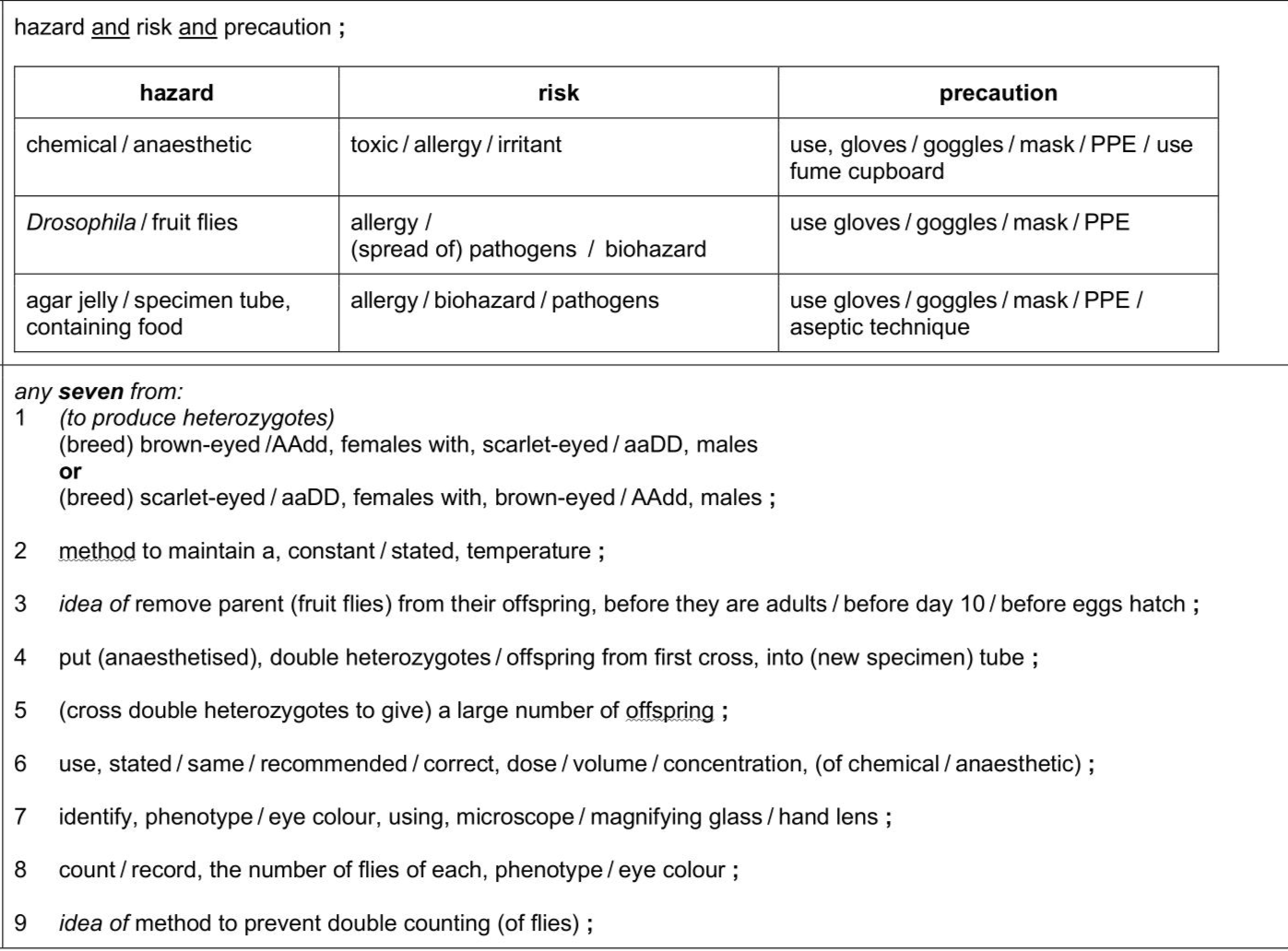Drosophila melanogaster is a species of fruit fly. Scientists have studied the inheritance patterns of many genetic traits in fruit flies. To carry out genetic crosses with fruit flies: - a specimen tube is prepared with food for the fruit flies, as shown in Fig. 1.2 - adult male and female fruit flies are added to the specimen tube to allow mating to take place - the specimen tube is kept in warm conditions for several days - the eggs laid by female fruit flies develop into pupae - adults are removed from the specimen tube before pupae mature into adult fruit flies - offspring emerge as adult flies $$\(10-15\)$$ days after eggs are laid. One of the genetic traits studied in fruit flies is eye colour.The normal(wild type)eye colour of D.melanogaster is red. Eye colour in D.melanogaster is controlled by several genes,including two genes that are located on separate chromosomes, $$\(\mathbf{A} / \mathbf{a}\)$$ and $$\(\mathbf{D} / \mathbf{d}\)$$ . -Allele A is dominant to allele a. -Allele D is dominant to allele d. (a)A student was provided with two populations of fruit fly: -brown-eyed fruit flies with genotype AAdd -scarlet-eyed fruit flies with genotype aaDD. In each population,males and females were provided in separate specimen tubes. The student decided to carry out two genetic crosses. The first cross used fruit flies from the initial populations to produce offspring that are heterozygous for each of the two genes(double heterozygotes). The second cross used the double heterozygotes produced from the first cross. To carry out the genetic crosses,the student was provided with standard laboratory equipment and: -specimen tubes containing food -a chemical to anaesthetise the flies-this chemical,when given at a particular dose, makes the flies immobile for more than 30 minutes -small brushes for sorting immobile flies without harming them. (i)Identify a hazard in this investigation and state a risk associated with the hazard and state one precaution that the student should take. . . [1] (ii) Describe a method the student could use to carry out: - the first cross using fruit flies from the initial two populations to produce double heterozygotes (genotype AaDd) - the second cross using the double heterozygotes produced from the first cross - an analysis of the offspring phenotype ratio from the second cross. The description of your method should be set out in a logical way and be detailed enough for another person to follow. The method should include a description of how offspring phenotypes would be identified. . . . . . . . . . . . . . . . . . . . . (iii) Predict the ratio of offspring phenotypes from the cross between parents that are heterozygous for the two genes (AaDd). You may use this space for any working. ratio phenotypes
Exam No:9700_s25_qp_53 Year:2025 Question No:1(a)
Answer:


Knowledge points:
16.1.1 explain the meanings of the terms haploid (n) and diploid (2n)
16.1.2 explain what is meant by homologous pairs of chromosomes
16.1.3 explain the need for a reduction division during meiosis in the production of gametes
16.1.4 describe the behaviour of chromosomes in plant and animal cells during meiosis and the associated behaviour of the nuclear envelope, the cell surface membrane and the spindle (names of the main stages of meiosis, but not the sub-divisions of prophase I, are expected: prophase I, metaphase I, anaphase I, telophase I, prophase II, metaphase II, anaphase II and telophase II)
16.1.5 interpret photomicrographs and diagrams of cells in different stages of meiosis and identify the main stages of meiosis
16.1.6 explain that crossing over and random orientation (independent assortment) of pairs of homologous chromosomes and sister chromatids during meiosis produces genetically different gametes
16.1.7 explain that the random fusion of gametes at fertilisation produces genetically different individuals
16.2.1 explain the terms gene, locus, allele, dominant, recessive, codominant, linkage, test cross, F1, F2, phenotype, genotype, homozygous and heterozygous
16.2.2 interpret and construct genetic diagrams, including Punnett squares, to explain and predict the results of monohybrid crosses and dihybrid crosses that involve dominance, codominance, multiple alleles and sex linkage
16.2.3 interpret and construct genetic diagrams, including Punnett squares, to explain and predict the results of dihybrid crosses that involve autosomal linkage and epistasis (knowledge of the expected ratios for different types of epistasis is not expected)
16.2.4 interpret and construct genetic diagrams, including Punnett squares, to explain and predict the results of test crosses
16.2.5 use the chi-squared test to test the significance of differences between observed and expected results (the formula for the chi-squared test will be provided, as shown in the Mathematical requirements)
16.2.6.1 TYR gene, tyrosinase and albinism
16.2.6.2 HBB gene, haemoglobin and sickle cell anaemia
16.2.6.3 F8 gene, factor VIII and haemophilia
16.2.6.4 HTT gene, huntingtin and Huntington’s disease
16.2.7 explain the role of gibberellin in stem elongation including the role of the dominant allele, Le, that codes for a functional enzyme in the gibberellin synthesis pathway, and the recessive allele, le, that codes for a non-functional enzyme
Solution:
Download APP for more features
1. Tons of answers.
2. Smarter Al tools enhance your learning journey.
IOS
Download
Download
Android
Download
Download
Google Play
Download
Download
